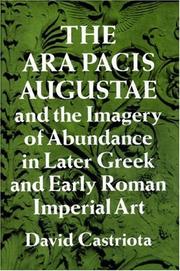Check nearby libraries
Buy this book

David Castriota examines one of the most important monuments of early Roman Imperial art, the Ara Pacis Augustae, the sculptured marble altar built to celebrate the peace, prosperity, and stability initiated by the reign of Augustus in the later first century B.C. Castriota argues that the floral decoration of the altar enclosure was profoundly significant, operating as a visual counterpart to the technique of metonymy in language.
Supporting his argument with evidence from Greek and Roman literature and religion, Castriota shows that the planners of the Ara Pacis adapted and expanded a long tradition of symbolic floral decoration from Greek monumental arts. Throughout his work Castriota demonstrates that the Roman absorption of Greek precedent enabled viewers to recognize the intended message of divine sponsorship.
By examining the origins of the Ara Pacis within its broader historical setting, the author provides new insights into a crucial period that witnessed the emergence of a distinctly Roman Imperial art.
Check nearby libraries
Buy this book

Previews available in: English
Subjects
Ara Pacis (Rome, Italy), Friezes, Hellenistic Sculpture, Influence, Marble sculpture, Roman, Peace in art, Plants in art, Relief (Sculpture), Roman, Roman Marble sculpture, Sculpture, Hellenistic, Relief (sculpture), Sculpture, Rome (italy), Relief (sculpture), roman--italy--rome, Marble sculpture, roman--italy--rome, Friezes--italy--rome, Sculpture, hellenistic--influence, Nb133 .c37 1995, 733/.5/09376Showing 1 featured edition. View all 1 editions?
| Edition | Availability |
|---|---|
|
1
The Ara Pacis Augustae and the imagery of abundance in later Greek and early Roman imperial art
1995, Princeton University Press
in English
0691037159 9780691037158
|
aaaa
Libraries near you:
WorldCat
|
Book Details
Edition Notes
Includes bibliographical references (p. [231]-236) and index.
Classifications
The Physical Object
ID Numbers
Source records
amazon.com recordBetter World Books record
Library of Congress MARC record
ISBNdb
marc_columbia MARC record
Work Description
David Castriota examines one of the most important monuments of early Roman Imperial art, the Ara Pacis Augustae, the sculptured marble altar built to celebrate the peace, prosperity, and stability initiated by the reign of Augustus in the later first century b.c. Castriota argues that the floral decoration of the altar enclosure was profoundly significant, operating as a visual counterpart to the technique of metonymy in language. It utilized an array of realistic plants and flowers as allusive elements associated with various gods and goddesses, which together symbolized the support and blessing of the Roman divinities for the Augustan regime.
Supporting his argument with evidence from Greek and Roman literature and religion, Castriota shows that the planners of the Ara Pacis adapted and expanded a long tradition of symbolic floral decoration from Greek monumental arts. Throughout his work, Castriota demonstrates that the Roman absorption of Greek precedent enabled viewers to recognize the intended message of divine sponsorship. By examining the origins of the Ara Pacis within its broader historical setting, the author provides new insights into a crucial period that witnessed the emergence of a distinctly Roman Imperial art.
David Castriota is Assistant Professor of Art History at Sarah Lawrence College. He is the author of Myth, Ethos, and Actuality: Official Art in Fifth Century b.c. Athens.
Community Reviews (0)
Feedback?| July 17, 2024 | Edited by MARC Bot | import existing book |
| December 19, 2023 | Edited by ImportBot | import existing book |
| July 31, 2020 | Edited by ImportBot | import existing book |
| June 22, 2013 | Edited by Carlos Oia | Edited without comment. |
| December 10, 2009 | Created by WorkBot | add works page |









